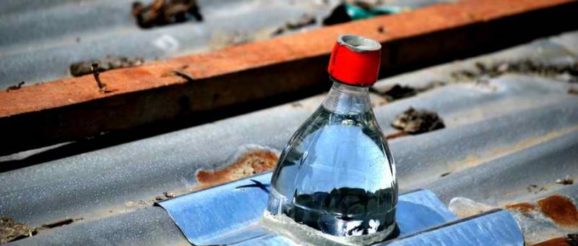This Frugal Innovation won the Future Energy Prize

As this webpage often has pointed out, lives around the world are often more different than we think. In the developed world, technology storms forward at such a staggering pace that we sometimes do not contemplate over the fact that electricity and light have not reached all corners of the world. In fact, there are millions and millions who do not have access to electricity. So how do you go about to get a light indoors at nighttime?
According to Inhabitat, millions of people in the poor villages and slums of the Philippines live their daily lives without any kind of indoor light at all. That’s right, millions in only that particular country. In some of the less fortunate places on the islands there is electricity, but it seldom lives up to any safety standard to talk about. Allegedly, the connections are oftentimes prone to cause fire, since they are faulty and outdated. The alternative is to use dangerous kerosene lamps for indoor lighting, but these are not a good option considering their inherent risks (see below). This background to the widespread issue of being off the grid (or exposed to danger) makes it clear that another solution for lighting has been badly needed.
The Independent writes that more than 1.5 billion people around the world currently have no access to electric light, and around 1.3 billion of them must spend up to half their income on kerosene to light their homes at night. Kerosene, which in many countries is called paraffin, kills around 1.5 million people in fires, bronchitis and lung cancer around the world each year. Fortunately, a viable option has been created and it is rapidly gathering speed. A Liter of Light is a global open source movement with the aim to provide an ecologically sustainable and free-of-cost source of interior light to rooms in simple dwellings with a thin roof. By fitting a plastic a bottle filled with water and a small amount of bleach through the roof of house and equipping it with simple and cheap solar electronics, it charges during the day and deliver an equivalent of 40-60 watts of light when it is needed. Also, it lasts for up to 5 years, costs less than US$2 and is easy to assemble, install and maintain, according to Vision.ae.
According to Wired, many thousands of people already use the invention instead of kerosene, and it is much safer, environmentally friendly and also a lot cheaper. A group of MIT students started the initiative just a few years ago, but according to the initiative’s homepage the project has inspired so many that it has now committed to a goal of placing 1,000,000 bottle lights in households all over the world during 2015. Moreover, today the 19th of February, the world’s biggest award for renewable energy and sustainability honored the organization for an innovative lighting solution that addresses the combined challenge of climate change, energy security, and the environment.
The founder and CEO of A Liter of Light demonstrates the innovation’s capacity
The founder and CEO Illac Diaz received The Zayed Future Energy Prize in the non-profit category in competition with many hundreds of applicants. According to Manila Standard Today, he greeted the prize with the following statement:
“Ours is a story about the power of harnessing open source technologies and sharing them with young people around the world who are keen to solve energy poverty in their own communities”
The above statement is tied to how A Liter of Light empowers communities by training locals how to manufacture and install solar lights, creating hundreds of job opportunities for sectors not commonly involved with energy, such as rural women’s cooperatives, youth groups, and refugee camps. We have only one thing to add: keep up the good work.
The post This Frugal Innovation won the Future Energy Prize appeared first on Mistbreaker News.
